Quick Facts

Biography
Carl Gustav Carus (3 January 1789 – 28 July 1869) was a German physiologist and painter, born in Leipzig, who played various roles during the Romantic era. A friend of Johann Wolfgang von Goethe, he was a many-sided man: a doctor, a naturalist, a scientist, a psychologist, and a landscape painter who studied under Caspar David Friedrich.
Life and work

In 1811 he graduated as a doctor of medicine and a doctor of philosophy. In 1814 he was appointed professor of obstetrics and director of the maternity clinic at the teaching institution for medicine and surgery in Dresden. He wrote on art theory. From 1814 to 1817 he taught himself oil painting working under Caspar David Friedrich, a Dresden landscape painter. He had already taken drawing lessons from Julius Diez and subsequently studied under Julius Schnorr von Carolsfeld at the Oeser drawing academy.
When the King of Saxony, Frederick Augustus II, made an informal tour of Britain in 1844, Carus accompanied him as his personal physician. It was not a state visit, but the King, with Carus, was the guest of Queen Victoria and Prince Albert at Windsor Castle, and Carus was able to visit many of the sights in London and the university cities of Oxford and Cambridge, and meet others active in the field of scientific discoveries. They toured widely in England, Wales and Scotland, and afterwards Carus published, on the basis of his journal, The King of Saxony's Journey through England and Scotland, 1844.

He is best known to scientists for originating the concept of the vertebrate archetype, a seminal idea in the development of Darwin's theory of evolution. In 1836, he was elected a foreign member of the Royal Swedish Academy of Sciences. Carus is also noted for Psyche (1846).
Carl Jung credited Carus with pointing to the unconscious as the essential basis of the psyche.
- Although various philosophers, among them Leibniz, Kant, and Schelling, had already pointed very clearly to the problem of the dark side of the psyche, it was a physician who felt impelled, from his scientific and medical experience, to point to the unconscious as the essential basis of the psyche. This was C. G. Carus, the authority whom Eduard von Hartmann followed. (Jung [1959] 1969, par. 259)
Carus died in Dresden. He is buried in the Trinitatis-Friedhof (Trinitatis Cemetery) east of the city centre. The grave lies in the south-west section, against the southern wall. The grave is currently (2015) identified for removal due to non-payment of fees.
Written works


- Zoology, entomology, comparative anatomy, evolution
- Lehrbuch der Zootomie (1818, 1834).
- Erläuterungstafeln zur vergleichenden Anatomie (1826–1855).
- Von den äusseren Lebensbedingungen der weiss- und kaltblütigen Tiere (1824).
- Über den Blutkreislauf der Insekten (1827).
- Grundzüge der vergleichenden Anatomie und Physiologie (1828).
- Lehrbuch der Physiologie für Naturforscher und Aerzte (1838)- also medical
- Zwölf Briefe über das Erdleben (1841).
- Natur und Idee oder das Werdende und sein Gesetz. 1861.
- Medical
- Lehrbuch der Gynekologie (1820, 1838).
- Grundzüge einer neuen Kranioskopie (1841).
- System der Physiologie (1847–1849).
- Erfahrungsresultate aus ärztlichen Studien und ärztlichen Wirken (1859).
- Neuer Atlas der Kranioskopie (1864).
- Psychology, metaphysics, race, physiognomy
- Vorlesungen über Psychologie (1831).
- Psyche; zur Entwicklungsgeschichte der Seele (1846, 1851).
- Über Grund und Bedeutung der verschiedenen Formen der Hand in veschiedenen Personen (About the reason and significance of the various forms of hand in different persons)(1846).
- Physis. Zur Geschichte des leiblichen Lebens (1851).
- Denkschrift zum 100jährigen Geburtstagsfeste Goethes. Über ungleiche Befähigung der verschiedenen Symbolik der menschlichen Gestalt (1852, 1858).
- Über Lebensmagnetismus und über die magischen Wirkungen überhaupt (1857).
- Über die typisch gewordenen Abbildungen menschlicher Kopfformen (1863).
- Goethe dessen seine Bedeutung für unsere und die kommende Zeit (1863).
- Lebenserinnerungen und Denkwürdigkeiten – 4 volumes (1865–1866).
- Vergleichende Psychologie oder Geschichte der Seele in der Reihenfolge der Tierwelt (1866).
- Art
- Neun Briefe über Landschaftsmalerei. Zuvor ein Brief von Goethe als Einleitung (1819–1831).
- Die Lebenskunst nach den Inschriften des Tempels zu Delphi ( 1863).
- Betrachtungen und Gedanken vor auserwählten Bildern der Dresdener Galerie (1867).
Art gallery


The Imperial Castle
Erinnerung an Sorrent (In Memory of Sorrento), 1828
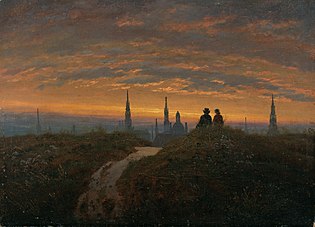

Carl Gustav Carus - Barge Trip on the Elbe near Dresden (Morning on the Elbe)
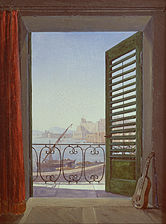
Balcony Room with a View of the Bay of Naples , 1829 or 1830.

Italienischer Mondschein (Rom, Peterskirche im Mondschein)

Tintern Abbey
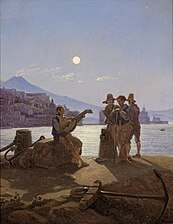
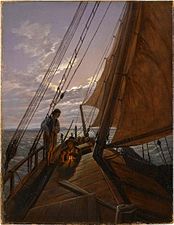
Segelschiff

Vollmond bei Pillnitz

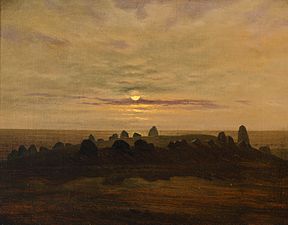
File:Carl Gustav Carus Stone Age Mound.jpg













